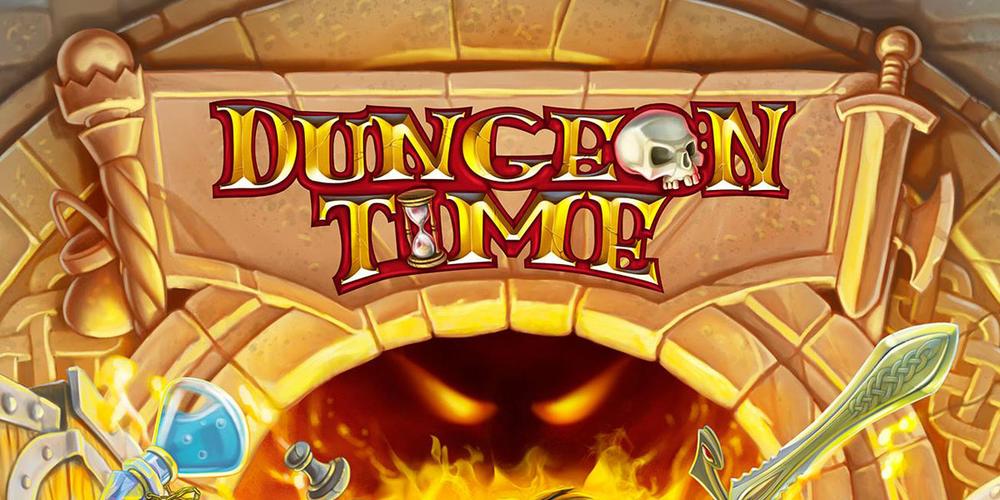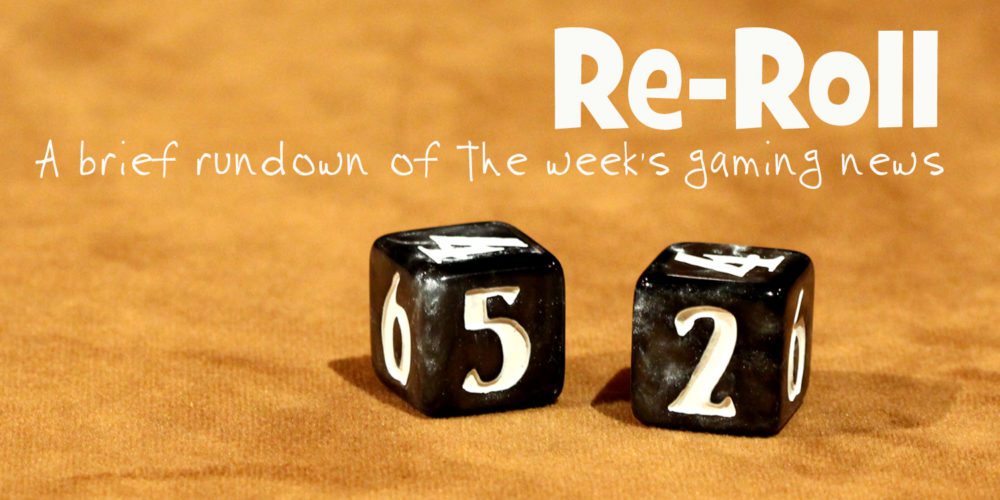It’s Dungeon Time! You have five minutes to get in, find the right equipment to accomplish your missions, and get out. But don’t overload your backpack!
At a glance: Dungeon Time is a cooperative game for 1 to 5 players, ages 8 and up, and takes about 10 minutes to play. It’s currently seeking funding on Kickstarter, with a pledge level of $25 for a copy of the game. The game works for both younger and older players, and has several difficulty levels so that it can easily be tuned for the group.
New to Kickstarter? Check out our crowdfunding primer.
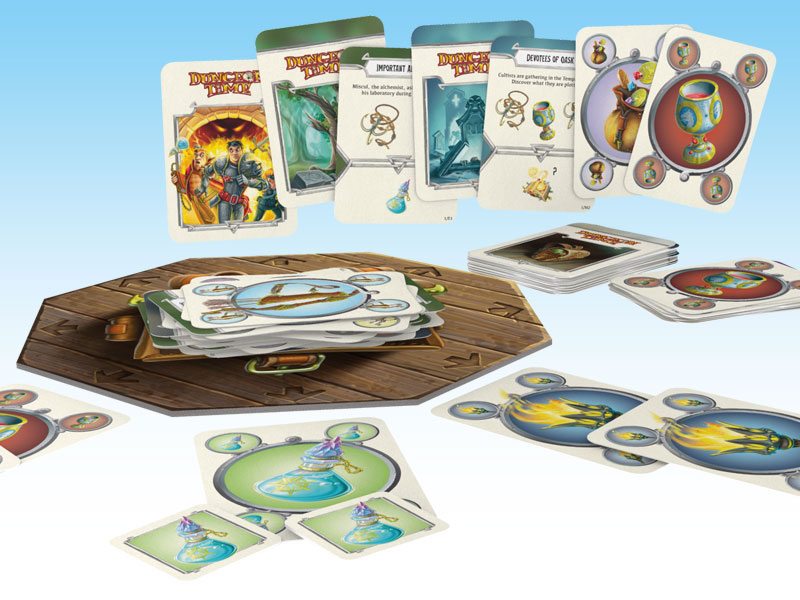
Components:
Note: My review was based on a demo prototype, so it only had the cards themselves and no other components. I can’t comment on the final quality of the finished components.
The game includes:
- 48 Item cards (4 each of 12 types)
- 12 Forest Mission cards
- 12 Graveyard Mission cards
- 12 Dungeon Mission cards
- 12 Dragon Mission cards
- 8 Character cards
- 24 Reward tokens (2 each of 12 types)
- 1 Backpack board
- 1 scoring pad
- 1 player aid
- 1 5-minute sand timer
The 12 item types include things like weapons, a keyring, a spellbook, and herbs. The same 12 items are on the Reward tokens as well (in the prototype the Rewards are also cards, just with a different card back and border). The illustrations on these are pretty nicely done—each card just has the large illustration in the middle and four smaller versions in the card corners.
The Mission cards have a little bit of flavor text on them, but the reality is that you won’t be reading these during the game because you’re frantically trying to accomplish missions. For instance the “Deadly Taste” mission says “The Count of Tirky hired you to verify that the food for the Firefly Festival is not poisoned.” The items required to accomplish each mission sometimes fit thematically, but sometimes don’t. In any case, if the overall theme is that you’re finding things in a dungeon to accomplish tasks, the 5-minute limit is sort of a weird theme anyway. I did notice at least on the prototype that there are a lot of typos and misspellings, so hopefully those will be corrected before the final game goes to print.
My prototype did not have the Backpack, an octagonal board so that each side is a “slot,” and each slot can hold up to 3 of the same item.
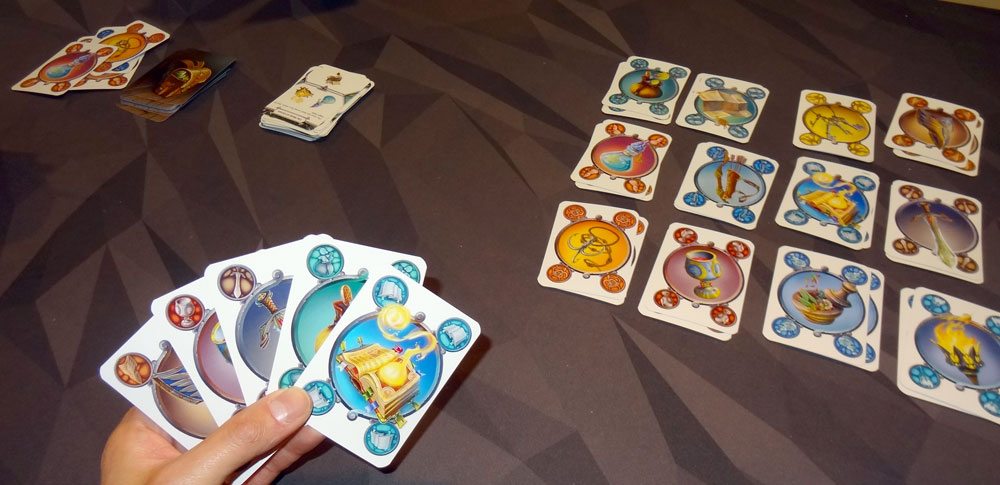
How to Play
The goal of the game is to finish a set number of missions (based on the difficulty level) before time runs out without overloading the backpack.
To set up, you pick a difficulty level: the easiest uses 12 Forest Missions, and the hardest uses 12 Dragon Missions, but you can also take a mix of 6 of two different difficulty types. Based on the difficulty level, you’ll have a different number of missions to complete: the easier levels actually have more missions to complete (but they’re easier). The Missions are shuffled together with the Item cards to form a single deck. The Reward tokens are set aside for now. Deal cards from the deck to players (the number of cards depends on the number of players) and then set the deck within reach of all players.
Start the timer, and go!
The first part of the game, played within the 5 minutes, is the Mission phase. After that concludes, there is a Resolution phase.
Once the timer starts, everyone plays at the same time, without taking turns. Cards are played in a single face-up pile. The idea is to play the correct Item cards needed to complete Mission cards, and then play the Mission cards into the pile. Mission cards also include a reward item, though this is not added to the pile during the Mission phase. Whenever you play cards, you draw back up to your hand size. You may also discard cards at any time (into a separate discard pile) to draw back up if you feel you don’t have anything useful in your hand.
The Mission phase ends when the timer runs out, or when there are no more Mission cards left to play. If time is up, any unplayed cards are placed into the discard pile.
During the Resolution phase, you find out whether you succeeded.
Flip the entire stack over, and then start playing out the cards one at a time. Items are placed into the backpack. Each slot in the backpack can hold up to 3 of the same type of item. If you ever have to add items to the backpack and there’s no more room, it bursts and you lose the game.
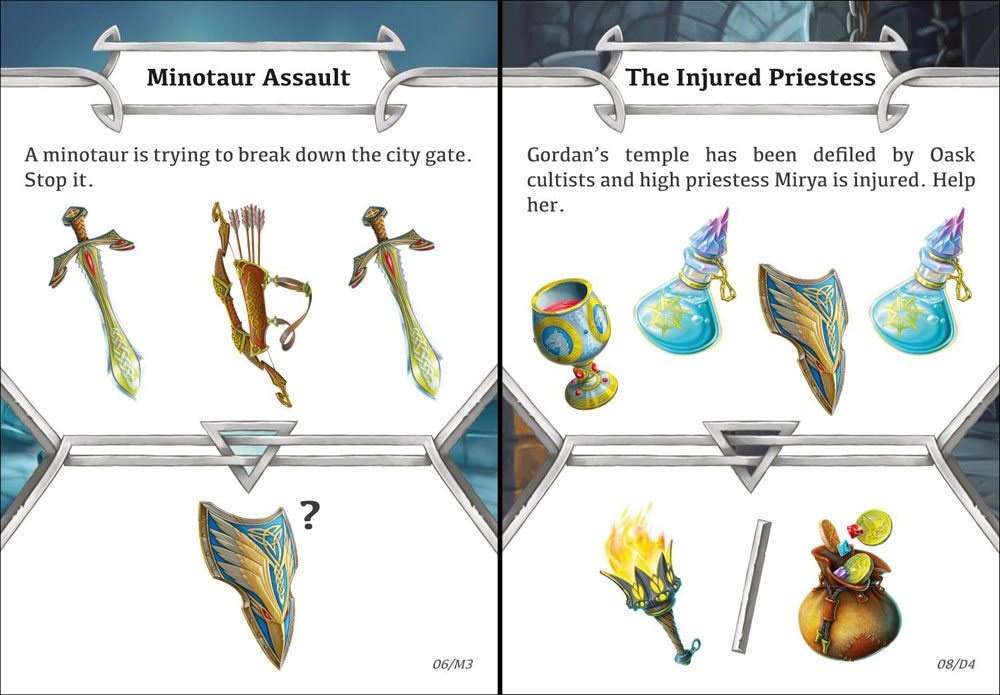
Whenever a Mission card is played, check the backpack to see if the necessary items are in the backpack. If so, remove those items from the Backpack and then place the Mission in a completed pile. If not, the Mission card is discarded, and then players must decide whether to keep or discard any of the items in the Backpack that do apply toward the discarded Mission.
Finally, after a Mission is successfully completed, there is a reward printed on the card. Depending on the difficulty level of the Mission, you may get to choose whether to take the reward or not, or choose what reward to take. If you take a reward, add the matching Reward token to the Backpack.
If you get through the entire deck without bursting the Backpack, then check how many Missions you accomplished—you win if you accomplished the set number needed.
There are some variants included in the rules: for instance, you can play again with only 7 slots in the Backpack, or shuffle all of the Mission cards and deal 12 at random, and so on. For solo play, you get a hand of 15 cards.

The character cards were not included in my prototype, but they each have one-time use powers that can be activated during the Resolution phase.
The Verdict
I’m a fan of real-time games, and Dungeon Time is a fun, fast-paced game that plays in just minutes. It’s quite likely that you’ll want to play again as soon as you finish, win or lose. The game requires a mix of memory, communication, a bit of luck, and speed. If you spend too long making decisions, you just won’t get through the deck in time.
I’ve mostly played at the easier levels (since I’ve been teaching new players usually) and they are pretty easy—which is why Ares Games has bumped up the number of missions you have to finish at those levels. Likewise, the harder levels get hard very quickly, so that has been tweaked as well. For the easy levels, it’s pretty easy to keep in mind which rewards have been used as you’re playing—players can just keep a running tally “Okay, remember there’s that sword we got a while back that we haven’t used yet…” and then you go for missions that use them up as quickly as possible. Once you get to the harder levels, though, it’s trickier because you have cards where you have to make a choice whether to take a reward or not, or which reward to take. By the time you do the Resolution, you may not remember if you opted for a torch or a bag of coins after assisting the injured priestess.
Messing up on a reward can then set off an entire chain reaction of failures. You thought you had opted for the torch, but it turns out that a later Mission really depended on having a bag of coins. So that Mission fails, which means the reward you would have gotten for it is missing, which causes another Mission to fail, and so on. The other tactic, of course, is to stuff extra items into the backpack—but then you risk overloading it and losing that way. It’s a delicate balance.
I’ve really been enjoying this one—I’ve played with both kids and adults and it’s fun for both groups. I like that the difficulty level can be tailored easily. Plus, it’s something that really forces you to use your memory and planning, and I think it’ll be a good one to play with my kids to work on their ability to pay attention and retain information. The rules are pretty easy to learn, although I’ve found that it’s helpful to just start in on a round and demonstrate the Resolution phase that way: people tend to grasp it after they see how things will play out.
Dungeon Time is a quick game, so even if you play a few rounds, it probably won’t make up an entire game night, but it’d be great for a lunch break game or to kick off a game night. For more information, check out the Dungeon Time Kickstarter page.
